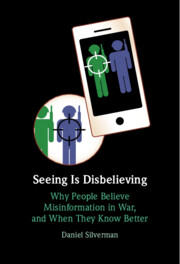Book contents
- Seeing Is Disbelieving
- Seeing Is Disbelieving
- Copyright page
- Dedication
- Contents
- Figures
- Tables
- Preface and Acknowledgments
- 1 Introduction
- 2 A Theory of People’s Factual Beliefs and Credulity in War
- 3 Factual Misperceptions in the US Drone Campaign in Pakistan
- 4 Proximity to the Fighting and the Puncturing of Factual Bias in Iraq
- 5 Truth Discernment and Personal Exposure in the Syrian Civil War
- 6 Understanding and Mitigating the Appeal of Falsehood in Wartime
- Appendix
- References
- Index
6 - Understanding and Mitigating the Appeal of Falsehood in Wartime
Published online by Cambridge University Press: aN Invalid Date NaN
- Seeing Is Disbelieving
- Seeing Is Disbelieving
- Copyright page
- Dedication
- Contents
- Figures
- Tables
- Preface and Acknowledgments
- 1 Introduction
- 2 A Theory of People’s Factual Beliefs and Credulity in War
- 3 Factual Misperceptions in the US Drone Campaign in Pakistan
- 4 Proximity to the Fighting and the Puncturing of Factual Bias in Iraq
- 5 Truth Discernment and Personal Exposure in the Syrian Civil War
- 6 Understanding and Mitigating the Appeal of Falsehood in Wartime
- Appendix
- References
- Index
Summary
This chapter concludes the book and considers its major theoretical and practical implications. It begins by exploring how the book pushes us to think about fake news and factual misperceptions as an important “layer” of war – a layer that has been largely neglected despite the burgeoning attention to these issues in other domains. This final chapter then examines what the book’s findings tell us about such topics as the psychology and behavior of civilian populations, the duration of armed conflicts, the feasibility of prevailing counterinsurgency models, and the depths and limits of misperceptions more broadly in social and political life. It also engages with the practical implications of the book for policymakers, journalists, activists, and ordinary politically engaged citizens in greater depth, exploring how the problems outlined in the research might also be their own solutions. Ultimately, this chapter shows how the book has something to offer to anyone who is interested in the dynamics of truth and falsehood in violent conflicts (and beyond) – and perhaps the beginnings of a framework for those who would like to cultivate more truth.
Keywords
- Type
- Chapter
- Information
- Seeing Is DisbelievingWhy People Believe Misinformation in War, and When They Know Better, pp. 126 - 153Publisher: Cambridge University PressPrint publication year: 2024



